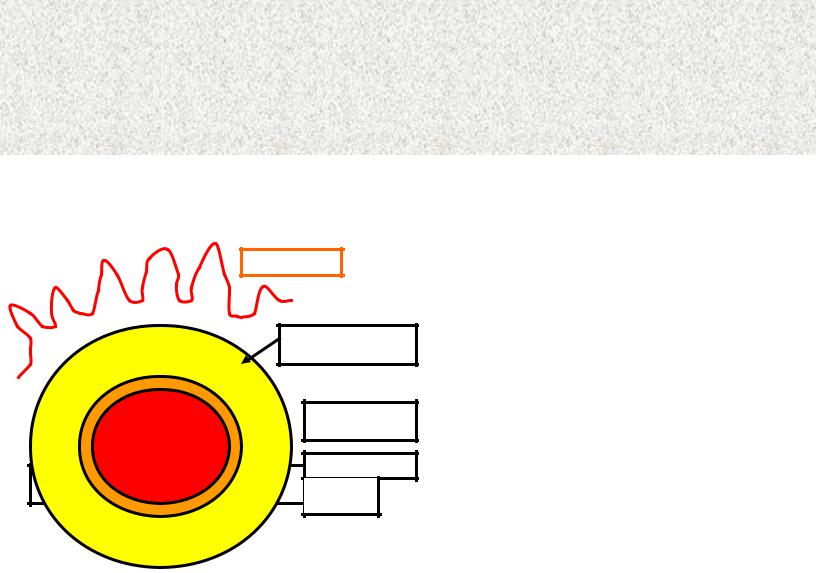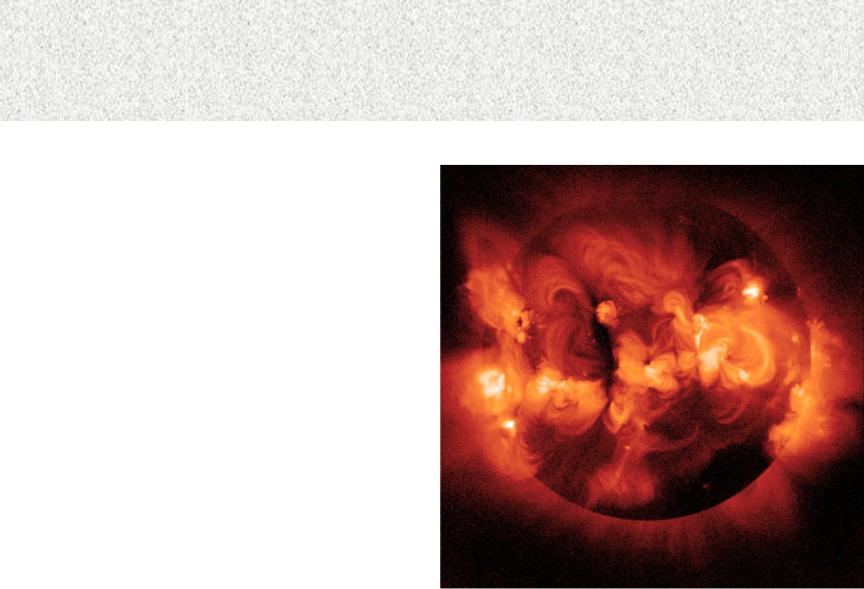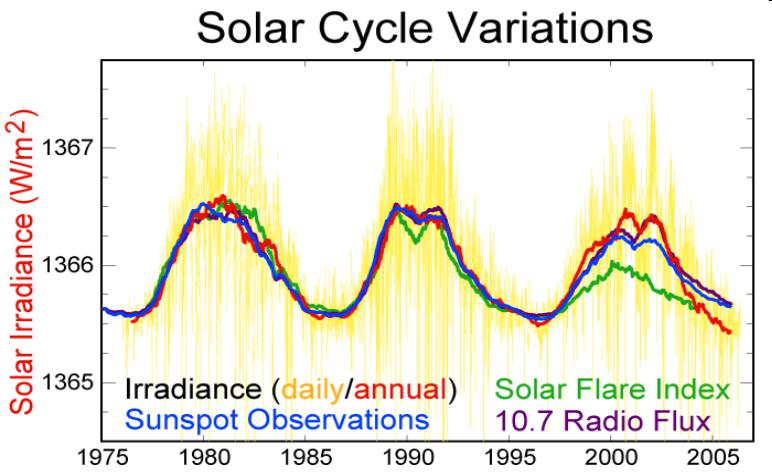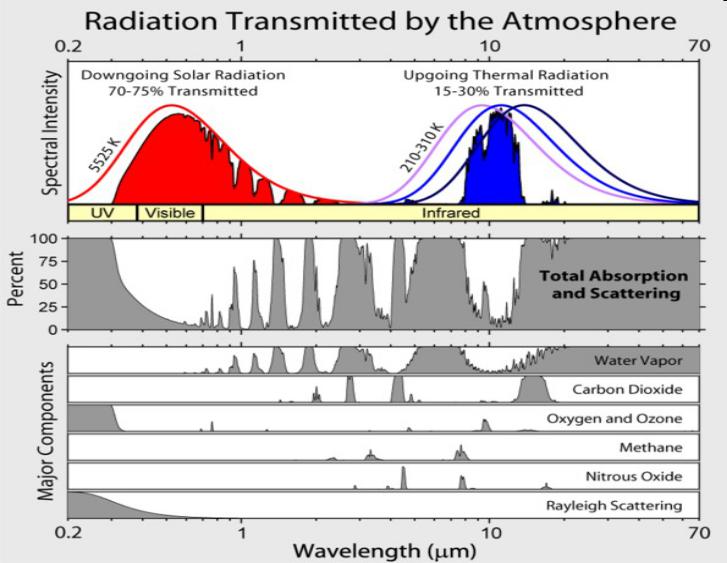
- •The Sun and Solar constant
- •Some particularities of the solar atmosphere
- •Two successive photos of a solar flare phenomenon evolving on the sun. The
- •Solar spots
- •http://en.wikipedia.org/wiki/File:Solar-cycle-data.png
- •Total spectrum of the solar radiation
- •http://en.wikipedia.org/wiki/File:Atmospheric_Transmission.png
- •Notion of OPTICAL WINDOW
- •Solar constant
- •Temperature of the Sun emitting surface
- •Difference between the insolation in Northern and southern hemispheres is explained by the
- •Distribution of the Sun energy in various areas of the spectrum
- •Solar radiation distribution over the globe
- •Insolation
- •The Q values in summer of the Southern hemisphere are bigger than corresponding

The Sun and Solar constant
Structure of the solar atmosphere
Solar corona
Chromosphere
H = 10000 -15000 km
Photosphere,  h = 100 – 300 km
h = 100 – 300 km
 T = 5000 – 6000 K
T = 5000 – 6000 K
 P = 100 hPa
P = 100 hPa
Temperature of the Sun atmosphere decreases as the distance from its centre increases.
At the top of the photosphere temperature is believed to be 5000 -6000 K. Photosphere, as well as chromosphere, consists of partly ionized gas and the solar corona of fully ionized gas (plasma).
1

Some particularities of the solar atmosphere
Solar atmosphere is non-homogeneous and very unstable.
Phenomena in the solar atmosphere
•Flares (факелы)
•Floccules-flocculi-flocculus (plasma blow out)
•Flashes (вспышки)
chromospheres flashes occur corpuscular and electromagnetic emanation are very rapid to increase
flashes duration: few minutes to a few hours. Corpuscle’s speed of about 1000 km/s.
The distance between the Sun and the Earth is about 150 000 000 km.
is the time needed for the corpuscular flux to reach the Earth and to cause magnetic storm or aurora.
1500000001000 150000 42hours
2

Two successive photos of a solar flare phenomenon evolving on the sun. The solar disk was blocked in these photos for better visualization of the flare
A sunspot viewed close-up in ultraviolet light, taken by the TRACE spacecraft
http://en.wikipedia.org/wiki/File:Flare_and_after-flare_prominence.jpg |
http://en.wikipedia.org/wiki/Sunspot |
•Erudite question ;)
•Why Pluto is No Longer a Planet ?
3

Solar spots
Some relatively |
4600 K) of |
irregular |
are |
known as |
|
They are observed |
– 35 |
degrees in |
Duration: |
from a few |
|
The solar spots |
of SOLAR |
ACTIVITY (SA). |
|
Wolfer Number (WN) |
|
W k f 10g |
|
K is empirical coefficient, f indicates the total number of the spots, |
||
g denotes number of the spot groups. The WN fluctuates with the |
||
period of 11 years (7 – 11). Minimal SA |
Maximal SA |
|
|
WN 0 11 |
WN 40 240 |
4

http://en.wikipedia.org/wiki/File:Solar-cycle-data.png
5

Total spectrum of the solar radiation
1. |
Gamma rays |
|
|
|
5 |
|
|
|
|
|
|
|||
|
|
Visible wavelengths (μ) |
||||||||||||
|
|
|
|
10 |
|
|
|
|
|
|
|
|
||
2. |
X-rays |
|
5 |
|
|
|
2 |
|
|
|
|
|
||
|
|
|
|
|
|
|
|
|
||||||
Violet 0,39 – 0,455 |
|
|
|
|||||||||||
|
|
10 |
|
10 |
|
|
|
|
|
|
|
|||
3. |
Ultraviolet (UV) |
|
Blue |
|
|
0,455 – 0,485 |
|
|
||||||
|
|
|
|
|
|
|||||||||
|
|
|
|
0,001 |
0,39 |
|
|
|
||||||
4. |
Visible light |
|
|
Light blue 0,485 – 0,505 |
|
|
||||||||
|
|
|
|
|
||||||||||
|
|
|
|
0,39 0,76 |
|
|
|
|||||||
|
|
|
|
|
||||||||||
5. |
Infrared (IR) |
|
|
Green 0,5 5 – 0,575 |
|
|
||||||||
|
|
|
|
|
||||||||||
|
|
|
|
0,76 3000 |
|
|
|
|||||||
6. |
Radio waves |
|
|
Yellow 0,575 – 0,585 |
|
|
||||||||
|
|
|
|
|
||||||||||
|
|
|
|
3000 |
|
|
|
|||||||
|
|
|
|
|
||||||||||
|
Orange 0,585 – 0,620 |
|
|
|
|
|
|
|
|
|
||||
|
|
|
|
|
|
|
|
|
|
|||||
|
Red |
0,620 – 0,575 |
|
|
|
|
|
|||||||
|
|
|
|
|
|
|||||||||
|
|
|
|
|
|
|||||||||
The energy emitted by the Sun is generated deep within the Sun. Like most of the stars |
|
|
||||||||||||
|
||||||||||||||
|
the Sun is made up primary of hydrogen (71%) and helium (21%). The heavier |
|||||||||||||
|
elements occupy 2% only. Near the Sun centre temperature is about 16000000 K and |
|||||||||||||
|
the density is 150 times larger that of water. Under these conditions atoms of |
|||||||||||||
|
Hydrogen interact and form helium. This process generate energy in form of gamma |
|||||||||||||
|
radiation equal to |
|
hydrogen bombs per second. |
|||||||||||
E 1016
6

7

http://en.wikipedia.org/wiki/File:Atmospheric_Transmission.png |
8 |

Notion of OPTICAL WINDOW
Emittance of the Sun is close to the emittance of the a. Bb with the temperature 5800 K, max 0,4738 , and the most part of the SR
energy falls on the wavelength range 0,29 – 2,4 μ.
It has happened that the Earth’s atmosphere is the most transparent just for the same wavelength range. That is why we call this range
OPTICAL WINDOW
Wavelengths, μ |
Part of SR allowed for |
|
passing |
<0,29 |
1% |
0,29 – 2,4 |
80% |
>2,4 |
3,6% |
Radio wave |
100% |
9

Solar constant
The amount of SR (radiation flux) coming to the upper boundary of the Earth atmosphere in a unit of time to a unit of area facing the rays, at average distance between the Sun and the Earth is called
SOLAR CONSTANT |
I* 1,37 kW |
|||
According to satellite measurement |
|
0 |
|
m2 |
I* 1,368 1,377 kW |
m2 |
|
|
|
0 |
|
|
|
|
Some recent measurement recorded |
I0* 1,379 1,38kW |
m |
2 |
|
|
|
|
|
|
This constant includes the energy of all wavelengths coming from the
Sun. Therefore we call it Astronomic Solar Constant |
|
||||
For the upper part of the troposphere |
|
|
|
I* 1,26kW |
m2 |
|
|
|
|||
(for the wavelength interval 0,346 2,4 |
) |
|
0 |
||
|
|
|
|||
We call it Meteorological Solar Constant.
10
